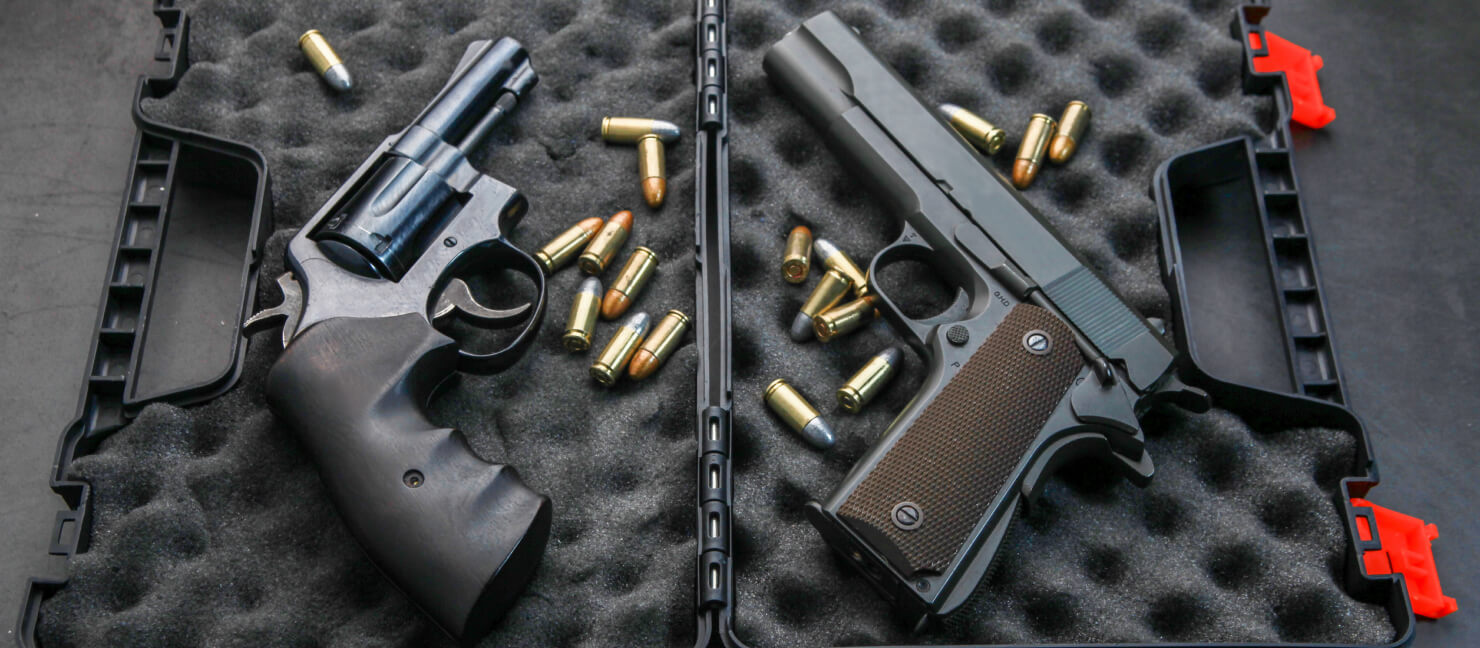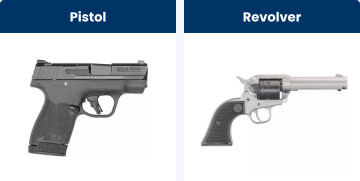Revolver vs Pistol: Comparing Power, Capacity, & More

Key Takeaways
- Revolvers vs Pistols (What You Should Know): Revolvers store ammo in their chambers and rely on the hammer to initiate the firing sequence. Pistols feed cartridges into the chamber via a magazine and use a hammer or striker to fire.
- Pros & Cons of Pistols: Pistols have a larger capacity and are easier to reload. Some shooters may find bigger pistols more difficult to conceal carry.
- Pros & Cons of Revolvers: Revolvers are reliable firearms that are beginner-friendly. Due to a heavy trigger pull and limited capacity, they may not be optimal for certain shooting situations.
What’s the Difference Between Revolvers & Pistols?
The major differences between a revolver and a pistol include the following: revolver’s chamber vs pistol’s magazine, general operation, ammo capacity (pistols commonly have 15 rounds), size, and firing chamber mechanism (a revolver’s chamber spins).
-
To operate a revolver, the shooter loads rounds into the cylinder, cocks the hammer back, and then fires the weapon.
-
In a pistol, cartridges are taken from the magazine and fed into the fixed chamber. When fired, the firing pin strikes the primer, and the expanding gasses propel the bullet through the barrel.

Ultimate Breakdown of Revolvers vs Pistols
Revolvers feature a cylinder that commonly houses about 6 rounds in its chambers. Typically, they produce more felt recoil compared to pistols. Pistols, however, offer a larger ammunition capacity.
While some shooters may refer to these guns interchangeably, they have distinct characteristics worth noting! Explore the differences between them in the table below:
| Revolver vs Pistol: Key Differences | ||
|---|---|---|
| Category | Pistols | Revolvers |
| Firing Operation | Pistols load a cartridge and ignite the primer with a hammer or striker | Once the hammer is cocked, the trigger initiates the firing sequence |
| Action Types | Semi-automatic, single-shot, multi-barrel | Single-action, double action/single action (DA/SA), double-action |
| Popular Calibers | 9mm, .45 ACP, .380 ACP, .40 S&W, .357 SIG, .22 LR, .44 Magnum | .38 Special, .357 Magnum, .44 Magnum, .45 Colt, .22 LR, .44 Special, .327 Federal Magnum |
| Popular Use Cases | Self-defense, concealed carry, law enforcement, sport shooting | Self-defense, concealed carry, sport shooting, cowboy action shooting (or single-action shooting) |
| Capacity, Magazines, & Clips | Typically higher capacity (e.g. 10+ rounds); can be used with a magazine | Limited cylinder capacity, e.g., 6 rounds. Can be used with half and full-moon clips |
| Reloading Times | Quick and easy magazine changes | Slower reloading, one round at a time |
Firing Operation
Both pistols and revolvers rely on the trigger to initiate the firing sequence. Revolvers rely solely on a hammer, while pistols can use a hammer or striker.
Pistol Firing Operation
|
Revolver Firing Operation
|

Action Types
In both the pistol and revolver categories, there are various types to explore. If possible, you can try shooting different types to see which feels best.
Pistol Actions
|
Revolver Actions
|
Expert Tip:
In Double Action Only revolvers, there's no single-action option. These revolvers have a concealed hammer, which is good for carrying discreetly.
Popular Caliber
When it comes to calibers, shooters need to consider their comfort and familiarity with the firearm. Revolvers typically use rimmed cartridges, while pistols use rimless or semi-rimmed cartridges.
Pistol Calibers |
Revolver Calibers
|
Use Cases
Shooters often choose between revolvers and pistols based on their specific needs. For concealed carry, many prefer revolvers, while some shooters value pistols thanks to their firepower.
Pistol Use Cases |
Revolver Use Cases
|
Capacity, Magazines & Clips

The pistol has a higher capacity than the revolver. This can be helpful in self-defense situations. However, there are ways to increase capacity with magazines and clips.
Pistol Capacity
|
Revolver Capacity
|
Reloading Times
Pistols generally offer faster reloading times when compared to revolvers. However, with practice and the use of a speedloader, you can achieve quicker reloads with a revolver.
Pistol Reloading Time
|
Revolver Reloading Time
|
Pros & Cons of Pistols
Pistols have been prized for their fast reloading capabilities and used by law enforcement departments. If you’re thinking of buying a pistol, see the major pros and cons.
Pistol Pros
|
Pistol Cons
|
Pros & Cons of Revolvers
Revolvers have a classic style and can be extremely fun to shoot, but it doesn’t mean they don’t come without drawbacks. See some of the pros and cons related to revolvers listed below.
Revolver Pros
|
Revolver Cons
|
Have Fun Out There!
Ready to make your first revolver or pistol purchase? Whichever firearm you decide on, both provide ample firepower to meet your specific requirements. Explore our range of revolvers for a classic Western vibe, or consider a semi-automatic pistol for fast firing. Don't forget to stock up on ammunition while you're at it.
 Gift Cards
Gift Cards Hot Deals
Hot Deals Big Fun Deals
Big Fun Deals Clearance
Clearance

